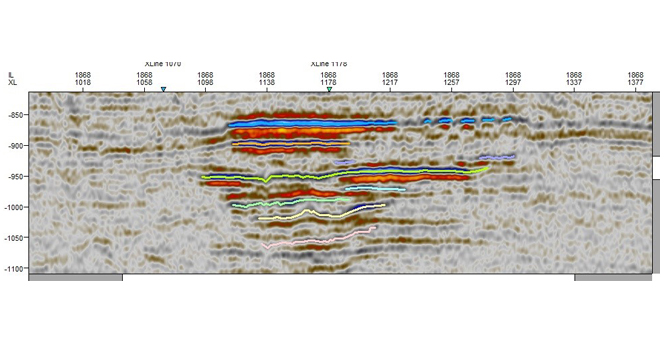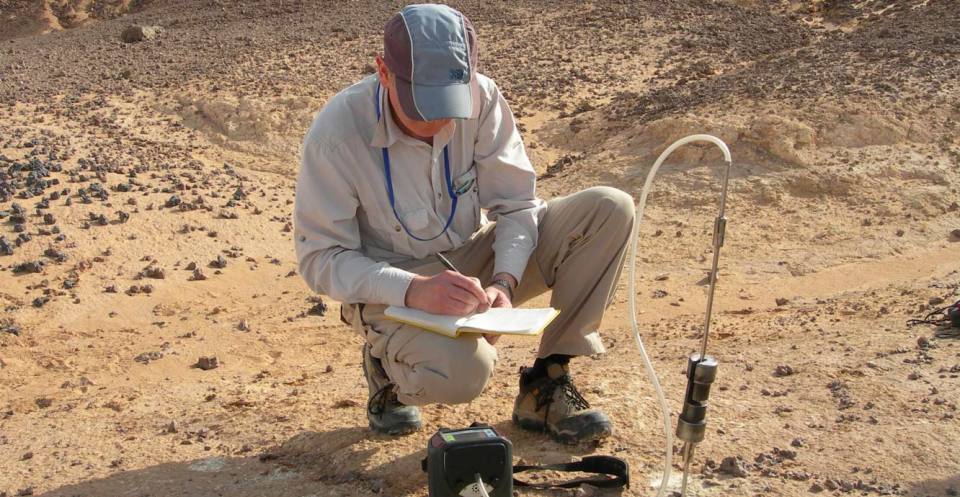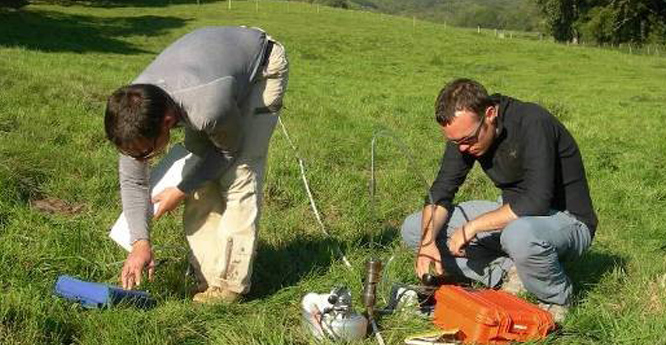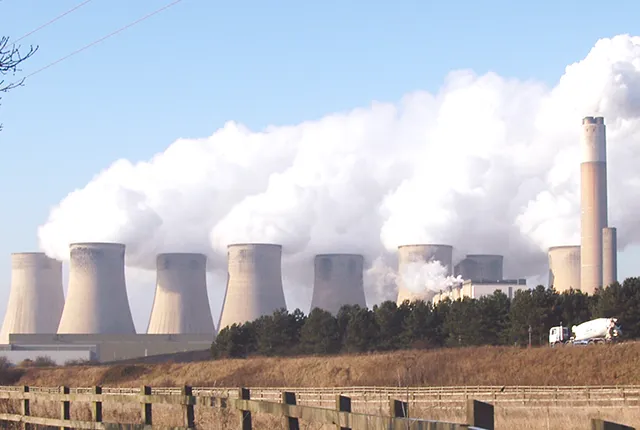A monitoring plan is essential before starting operations at a CO2 storage site and is required by regulations. Monitoring can be both deep-focused — imaging the storage site itself and the rocks immediately above it — or shallow-focused — monitoring whether any CO2 has escaped from the storage site and if any has managed to reach the surface. It is needed to show that CO2 is being stored safely and that any risks to resources and the environment are being properly managed.
Measurements will take place before injection as part of site characterisation and to define baseline conditions. They continue throughout injection of CO2 and into the post-injection stage until it is considered acceptable to cease monitoring.
See our Discovering Geology pages for more information on why we should monitor a storage site.
Deep monitoring
The primary objectives of deep monitoring are:
- to observe the distribution and migration of CO2 within a storage reservoir
- to assess increases in fluid pressure
- to provide early warning of unexpected CO2 migration, either within or outside of the storage reservoir
Additionally, deep monitoring permits improved characterisation of the reservoir and makes possible the identification of risks to containment of the injected CO2. Significantly, the outcomes of deep monitoring can be used to verify site performance.
We have been commissioned to review all aspects of current offshore monitoring practice. We have experience exploring how the present-day capabilities of deep monitoring interact with the relevant regulatory frameworks. The BGS is regularly called upon to identify areas for continuing research and development by national funding agencies.
Our experience in CO2 monitoring has led to our involvement in numerous EU funded projects. The ECO2 and CO2 Site Closure Assessment Research (CO2CARE) projects led to the development of guidelines for innovative and cost-effective monitoring strategies. Furthermore, tools to detect and quantify potential leakage of CO2 were developed. We also designed and built the IEAGHG Monitoring Selection Tool, a platform to inform operators which techniques should be prioritised as part of a complete monitoring strategy.
The BGS-led and EPSRC-funded DiSECCS project developed seismic monitoring tools and methodologies to image and characterise CO2 plumes within storage reservoirs whilst identifying and quantifying the associated injection-induced pressure build-up.

Seismic section from the Sleipner storage site (Norway) in 2008. The strong reflections represent the response and position of trapped layers of CO2. By 2008, over 10 million tonnes had been injected and, due to repeat surveys, it has been possible to track the migration of CO2 since injection commenced in 1996.
Chadwick, R A. 2010. Measurement and monitoring technologies for verification of carbon dioxide (CO2) storage in underground reservoirs. 203–239 in: Developments and Innovation in Carbon Capture and Storage Technology: Volume 2 — Carbon Dioxide Storage and Utilization. Maroto-Valer (editor). (Cambridge, UK: Woodhead Publishing Ltd.)
Chadwick, R A, and Noy, D J. 2010. History-matching flow simulations and time-lapse seismic data from the Sleipner CO2 plume. 1171–1182 in: Petroleum Geology: From Mature Basins to New Frontiers (Proceedings of the 7th Petroleum Geology Conference). Vining, B A, and Pickering, S C (editors). (London: Geological Society.)
Chadwick, R A, and Noy, D J. 2015. Underground CO2 storage: demonstrating regulatory conformance by convergence of history-matched modeled and observed CO2 plume behavior using Sleipner time-lapse seismics. Greenhouse Gases: Science and Technology, Vol. 5(3), 305–322.
Chadwick, R A, Arts, R, and Eiken, O. 2005. 4D seismic quantification of a growing CO2 plume at Sleipner, North Sea. 1385–1399 in: Petroleum Geology: North West Europe and Global Perspectives (Proceedings of the 6th Petroleum Geology Conference). Dore, A G, and Vining, B (editors). (London: Geological Society.)
Chadwick, R A, Williams, G A, Williams, J D O, and Noy, D J. 2012. Measuring pressure performance of a large saline aquifer during industrial scale CO2 injection: the Utsira Sand, Norwegian North Sea. International Journal of Greenhouse Gas Control, Vol. 10, 374–388.
Verdon, J P, Kendall, J M, Stork, A L, Chadwick, R A, White, D J, and Bissell, R. 2013. Comparison of geomechanical deformation induced by megaton-scale CO2 storage at Sleipner, Weyburn and In Salah. Proceedings of the National Academy of Sciences of the United States of America, 2013 Vol. 110(30), E2762–E2771.
White, J C, Williams, G A, and Chadwick, R A. 2013. Thin layer detectability in a growing CO2 plume: testing the limits of time-lapse seismic resolution. Energy Procedia, Vol. 37, 4356–4365.
White, J C, Williams, G A, Grude, S, and Chadwick, R A. 2015. Utilizing spectral decomposition to determine the distribution of injected CO2 at the Snøhvit Field. Geophysical Prospecting, Vol. 63(5), 1213–1223.
Williams, G A, and Chadwick, R A. 2012. Quantitative seismic analysis of a thin layer on CO2 in the Sleipner injection plume. Geophysics, Vol. 77(6), 245–256.
Contact
If you want to discover more about deep monitoring then please contact Jonathan Pearce.
Shallow monitoring
Shallow monitoring systems are mainly designed to detect and measure CO2 that has migrated into shallow geological formations, the soil or the seabed, and any emissions to the atmosphere or into sea water. Shallow-focused methods can be airborne (e.g remote sensing), deployed at the surface (e.g. atmospheric measurements; surface flux) or made in the shallow subsurface (e.g. soil gas; geochemical sampling).
Near-surface gas measurements are one way to assess potential leakage from geological CO2 storage. This approach is a highly visible means of assessing a possible hazard to near-surface ecosystems, which can be helpful for public reassurance. European regulation also requires leakage detection and any surface emissions of CO2 have to be quantified.
Near-surface measurements include:
- the concentration of gases in the soil
- the flux of gas from the ground into the atmosphere
- atmospheric readings close to the ground
Measurements can be made directly in the field or on gas samples brought back to a laboratory (which might be a field facility). Further information on BGS’s gas monitoring capabilities can be found here.
We have also been involved at all these types of sites in research into the possible environmental impacts of any CO2 leakage on near surface environments, onshore and offshore, and on drinking-water aquifers.
Near-surface gas measurements formed part of the International Weyburn-Midale project and were also supported by the EU Weyburn and CO2ReMoVe projects. Repeated surveys showed the high seasonal and year-on-year variability of near-surface gas concentrations and fluxes. Measurements made in 2011 were able to refute allegations of leakage from the Weyburn site.
Repeated near-surface gas measurements were also made at the In Salah project in Algeria, in part under the CO2ReMoVe project.

Studies were conducted at the Latera (central Italy) and Laacher See (western Germany) sites as part of the CO2GeoNet and CO2ReMoVe projects. Latera is a volcanic caldera where a number of known CO2 vents have been studied in pasture land. Laacher See is also a quiescent volcanic area where deep CO2 emerges into the lake and the adjoining meadows.

Florina is a sedimentary basin in northern Greece, where deep CO2 travels up faults (as in Latera and Laacher See) through drinking-water aquifers to reach the surface in arable and pastoral land. This site was studied during the RISCS project
Fiumicino is a site near the main Rome airport where lower-level leakage of CO2 is occurring and has been recently studied by the BGS and La Sapienza University of Rome.
ASGARD was set up by the University of Nottingham on its campus at Sutton Bonington, UK. Replicated plots were established where CO2 could be injected at shallow depth (60 cm) to observe the impact of higher soil CO2 concentrations (and reduced oxygen) on a range of crops, pasture and soil microbes. Studies here included work under the CO2GeoNet and RISCS projects.
The CO2 Field Lab was established in a sand and gravel quarry in southern Norway. A wide range of different shallow monitoring techniques were tested through a 20 m-deep injection of almost two tonnes of CO2, which passed through a shallow aquifer before escaping into the atmosphere.
Airborne remote sensing was assessed as a possible way of monitoring leakage at the Latera natural CO2 site in Italy for the CO2GeoNet project. Different indicators of plant stress were evaluated that showed responses to CO2. However, similar stress was also related to other factors, giving false positives.
Satellite interferometry (InSAR) has been used to measure small displacements of the ground surface (of up to 2–3 cm) that have been related to the injection of CO2 at depth, most notably at the In Salah site in Algeria.
Near-surface marine monitoring has been carried out at natural CO2 seeps, such as Panarea (southern Italy), CO2 storage sites, most notably Sleipner and Snøhvit in the Norwegian sector of the North Sea, and at a shallow injection experiment off the west coast of Scotland (QICS). In general, offshore techniques are less well developed than onshore methods but have been progressed under projects like RISCS and ECO2.
Whilst some aspects of CO2 detection offshore are similar to onshore measurements, there are significant differences in offshore monitoring. Bubbles of CO2 emitted from the seabed are rapidly dissolved in seawater. The bubbling gas can be detected by acoustic methods and imaged using techniques such as multibeam echosounding, sidescan sonar or seismic profiling. Dissolved CO2 can be measured directly or indirectly detected by pH changes that occur through the resultant acidification of the water or other secondary effects.
The QICS project involved a range of near-surface offshore monitoring techniques to measure CO2 injected into seabed sediments at shallow depth (11 m) that led to emissions of the gas into seawater.
Offshore monitoring methods have recently been reviewed for the IEA Greenhouse Gas (IEAGHG) research programme. Monitoring techniques are under development in an Energy Technologies Institute UK project on measurement, monitoring and verification that aims to produce an integrated, commercially available monitoring system.
Arts, R J, Jones, D G, Chadwick, R A, Klinkby, L, Bernstone, C, and Sørensen, A T. 2011. Development of a monitoring plan for the Vedsted structure in Denmark. Energy Procedia, Vol. 4, 3558–3565.
Bateson, L, Vellico, M, Beaubien, S E, Pearce, J M, Annunziatellis, A, Ciotoli, G, Coren, F, Lombardi, S, and Marsh, S. 2008. The application of remote-sensing techniques to monitor CO2-storage sites for surface leakage: Method development and testing at Latera (Italy) where naturally produced CO2 is leaking to the atmosphere. International Journal of Greenhouse Gas Control, Vol. 2, 388–400.
Beaubien, S E, Jones, D G, Gal, F, Barkwith, A K A P, Braibant, G, Baubron, J C, Ciotoli, G, Graziani, S, Lister, T R, Lombardi, S, Michel, K, Quattrocchi, F, and Strutt, M H. 2013. Monitoring of near-surface gas geochemistry at the Weyburn, Canada, CO2-EOR site, 2001–2011. International Journal of Greenhouse Gas Control, Vol. 16 (Supp. 1), S236–S262.
Blackford, J, Stahl, H, Bull, J M, Berges, B J P, Cevatoglu, M, Lichtschlag, A, Connelly, D, James, R H, Kita, J, Long, D, Naylor, M, Shitashima, K, Smith, D, Taylor, P, Wright, I, Akhurst, M, Chen, B, Gernon, T M, Hauton, C, Hayashi, M, Kaieda, H, Leighton, T G, Sato, T, Sayer, M D J, Suzumura, M, Tait, K, Vardy, M E, White, P R, and Widdicombe, S. 2014. Detection and impacts of leakage from sub-seafloor deep geological carbon dioxide storage. Nature Climate Change, Vol. 4, 1011–1016.
Feitz, A J, Leamon, G, Jenkins, C, Jones, D G, Moreira, A, Bressan, L, Melo, C, Dobeck, L M, Repasky, K, and Spangler, L H. 2014. Looking for leakage or monitoring for public assurance? Energy Procedia, Vol. 63, 3881–3890.
Jones, D G, Barlow, T, Beaubien, S E, Ciotoli, G, Lister, T R, Lombardi, S, May, F, Möller, I, Pearce, J M, and Shaw, R A. 2009. New and established techniques for surface gas monitoring at onshore CO2 storage sites. Energy Procedia, Vol. 1, 2127–2134.
Jones, D G, Lister, T R, Smith, D J, West, J M, Coombs, P, Gadalia, A, Brach, M, Annunziatellis, A, and Lombardi, S. 2011. In Salah gas CO2 storage JIP: Surface gas and biological monitoring. Energy Procedia, Vol. 4, 3566–3573.
Jones, D G, Barkwith, A K A P, Hannis, S, Lister, T R, Gal, F, Graziani, S, Beaubien, S E, and Widory, D. 2014. Monitoring of near surface gas seepage from a shallow injection experiment at the CO2 Field Lab, Norway. International Journal of Greenhouse Gas Control, Vol. 28, 300–317.
Jones, D G, Beaubien, S E, Barlow, T S, Barkwith, A K A P, Hannis, S D, Lister, T R Strutt, M H, Bellomo, T, Annunziatellis, A, Graziani, S, Lombardi, S, Ruggiero, L, Braibant, G, Gal, F, Joublin, F, and Michel, K. 2014. Baseline variability in onshore near surface gases and implications for monitoring at CO2 storage sites. Energy Procedia, Vol. 63, 4155–4162.
Contact
If you want to discover more about shallow monitoring then please contact BGS Enquiries.
IEAGHG monitoring network
The International Energy Agency Greenhouse Gas research and development programme has established a monitoring network for which the BGS is a steering group member. The network assesses new monitoring techniques as they become available.
Contact
If you want to discover more then please contact Jonathan Pearce.
You may also be interested in

Carbon capture and storage
Studying carbon dioxide storage as a recognised European centre of excellence in a number of research areas.



